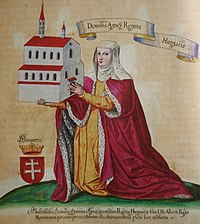Agnes of Austria (1281–1364)
| Agnes of Austria | |
|---|---|
 |
|
| Queen consort of Hungary | |
| Tenure | 1296–1301 |
| Born | 18 May 1281 |
| Died | 10 June 1364 (aged 83) Königsfelden, County of Tyrol, Holy Roman Empire |
| Burial | Königsfelden Monastery, County of Tyrol, Holy Roman Empire |
| Spouse | Andrew III of Hungary |
| House |
House of Habsburg House of Arpad |
| Father | Albert I of Germany |
| Mother | Elisabeth of Tirol |
Agnes of Austria (18 May 1281 – 10 June 1364) was a daughter of Albert I of Germany and his wife Elisabeth of Tirol. She was Queen of Hungary by marriage. She was a member of the House of Habsburg.
On 13 February 1296 in Vienna, Agnes married Andrew III of Hungary. Afterwards, with his father-in-law's support, Andrew managed to defeat the revolt of Miklós Kőszegi and Máté Csák III, and occupy the castles of Kőszeg and Pozsony. In 1298 Andrew supported with troops his father-in-law's revolt against King Adolf of Germany.
Agnes disliked tournaments, but liked sermons. Since she was small of stature, she used to wear dresses her sisters no longer wanted, which gained her praise for modesty.
The death of Andrew III on 14 January 1301, at Buda, ended the male line of the Árpáds. One of his contemporaries called him "the last golden twig of the Árpáds".
At that point, Agnes was a widow and she had no children to carry on the Arpad Dynasty. However she was only 19 so was still able to remarry and have children but she never did. Agnes became a patroness of Königsfelden Monastery in the County of Tyrol, which had been founded by her mother in memory of her late husband. Agnes took her stepdaughter Elizabeth with her and went to live there in a small house near the monastery. She was one of the final members of the Arpad family. Elizabeth was expected to marry Wenceslaus III of Bohemia, but the wedding never happened since Wenceslaus instead married Viola Elisabeth of Cieszyn. Left free, she became a Dominican nun at the nearby Töss Monastery, where she gained a reputation for holiness.
...
Wikipedia
